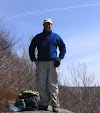This early/mid December pre-winter season has been more like January with prolonged cold temperatures and generous snowfall. Snowshoe season has been in full swing already.
OSSEO TRAIL
An afternoon jaunt at Lincoln Woods brought me partway up the Osseo Trail. Seen from the suspension bridge, the East Branch was on its way to freezing over.
Looking downstream to Scar Ridge from a banktop viewpoint.
When I saw that the Osseo Trail had a softly packed snowshoe track, I decided to head up that way as far as time permitted.
A powdery snowshoe track is a thing of beauty.
Love the first section that meanders alongside Osseo Brook.
The track was well set on the steep sidehill section along the initial section of the climb.
The rest of the lower two-mile stretch of Osseo follows an old logging road at easy/moderate grades deep into the Osseo Brook valley. Lots of nice hardwood out here.
Snow getting deeper.
I made it a mile and a half up Osseo Trail, to a point where I had this through-the-trees view of a wild spur of Whaleback Mountain across the valley. Nice backcountry feel out here.
Homeward bound.
BEAVER BROOK TRAIL
The next day I headed up to Kinsman Notch for a short, steep climb up the lower section of Beaver Brook Trail. There was just one car in the parking lot on a Saturday. I followed a single snowshoer's tracks up the trail. Good deep snow cover up here.
Careful snowshoe placement needed for two bridged brook crossings. Between the bridges I met the descending snowshoer, who had broken trail up to the Beaver Brook Shelter. Impressive work!
Crossing this bridge over a deep washout was definitely sketchy.
Deer tracks descending a steep slope.
The first cascade was mostly buried, as were those above.
Steep climbing with some backsliding in the slippery powder.
Looking down the brook above the first cascade.
A snow-smothered cascade farther up the trail.
Looking down. When fully locked in with ice and snow, these cascades are sometimes skied.
I turned around at the cascade where the trail makes its trickiest scramble.
Heading back down.
For the lower half of the descent, I bushwhacked down through 14" of heavy powder, thus avoiding a few steep rocky pitches and that narrow washout bridge. The woods through here are pretty much wide open.
Making fresh tracks.
Before heading home, I paid a brief visit to the open wetland at the south end of Beaver Pond, a wild and desolate place in winter.
GOODRICH ROCK
On a bitterly cold and windy day I went down to Waterville Valley with the idea of heading up Greeley Ponds Trail to whatever destination along that route presented itself. Mount Osceola and East Peak were looking wintry from the Valley floor.
There were both ski and snowshoe/boot tracks on the wide Greeley Ponds Trail.
The Mad River was in the process of freezing over.
The snowshoe track headed up the Goodrich Rock Trail. Beyond, there were only ski tracks. I did not want to trash those tracks, or break trail for a mile and a half to the viewpoint on Timber Camp Trail, or for two-plus miles to Lower Greeley Pond. Goodrich Rock it would be. It's one of a number of interesting trails maintained by the Waterville Valley Athletic & Improvement Association (WVAIA).
Starting out with a good snowshoe track on this entertaining trail.
The trail is spiced up with a few short, steep pitches.
The first of many cool boulders along this route.
This split rock is called the "Corridor Boulder."
The trail weaves right through it, though on this trip I followed the snowshoe track around it.
Looking in from the other end.
Bouldering enthusiasts call this overhanging giant the "House Boulder." Collectively this assemblage of glacial erratics on the flank of East Osceola s known as the Davis Boulders. They were discovered by Waterville cottage owner J.W. Davis in the 1890s, at which
time he laid out the original trail.
The trail passes between two more boulders.
The marked route passes through this cave-like slot. Not gonna happen with snowshoes and a big winter pack.
The titan of the group is known as the "Old, Old Wooden Ship."
A spruce-lined quarter mile of trail leads up to Goodrich Rock, one of the largest glacial erratics in New Hampshire.
A short steep and rough climb offers a bit of a challenge on snowshoes.
A tight squeeze.
Goodrich Rock, discovered by Watervilleans Arthur and Charles Goodrich around 1900. They estimated its size as 60 X 50 X 50 feet,
The trail passes along the base of this towering boulder, then wraps around and up to its back side.
A spicy 20-foot ladder, built by volunteers of the WVAIA, provides access up the back side of Goodrich
Rock. From the top there's a view across the valley to Sandwich Dome. Several times in winter I've climbed to the top of the ladder, but have always chickened out when it comes to making the step onto (and then back off) the sloping top of the rock. Today I didn't bother to climb the ladder, getting up here on a cold pre-winter day was good enough.







































































